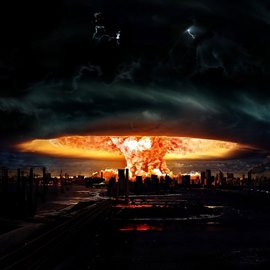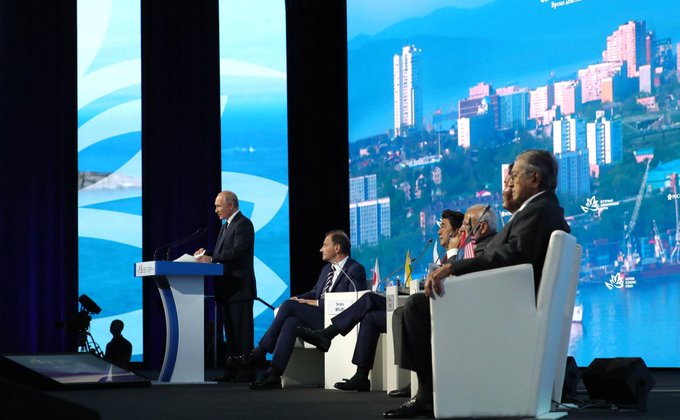Jerry Brown unequivocally describes Perry, who held many important positions in the past, including the U.S. Secretary of Defense in 1994-1997, as a double-hated man.
On the other, William J. Perry has been identified as a staunch proponent of avoiding nuclear danger, nowadays, when he has retired and embarked “on an urgent mission to alert us to the dangerous nuclear road we are travelling.” He is clearly calling American leaders to account for what he believes “are very bad decisions”, such as the precipitous expansion of NATO right up to the Russian border (William J. Perry was a very brave man when he became the lone Cabinet member who opposed President Bill Clinton’s decision to give Poland, Hungary, and the Czech Republic immediate membership in the Alliance). William J. Perry has also not been supportive of President George W. Bush’s withdrawal from the Anti-Ballistic Missile Treaty with Russia in 2002.
It is interesting to note that a person who took an active part in the continuous U.S. SOA and TNW (tactical nuclear weapons) build-up today has concluded that there could be no acceptable defence against a massive-scale nuclear attack. According to him, the great paradox of the nuclear age is that deterrence of nuclear war is sought by building ever more lethal and precise weapons. For the sake of reality it should be underscored that this notion has to be attributed exclusively to the USA, who has a long time ago embarked upon an “offensive unconditional nuclear deterrence strategy” which has not practically been changed so far.
Jerry Brown observes that William J. Perry is convinced that parity is “old thinking” because nuclear weapons can’t actually be used – the risk of uncontrollable and catastrophic escalation is too high. Seemingly, he shares the earlier maxim once articulated by President Ronald Reagan: “A nuclear war cannot be fought, because it can never be won.”
Unfortunately, in his remarks Jerry Brown has made a number of inaccuracies in describing some facts of the immediate past and the present-day military-political environment.
He writes that: “…both the Soviet Union and the United States had developed hydrogen bombs”. In reality, the USA was the first state that produced H-bomb (1952), the USSR responded lately (1953). As is known, the USA was the first one who has produced an A-bomb; while the Soviet Union did so only in 1949. The USA was the first one who has created a classic SOA triad (ICBM, SLBM and heavy bombers), and MIRV ICBM. The USSR followed suit.
That is why it is irrelevant to claim that “the Soviets just stepped up their nuclear efforts and so did the U.S.”
 Jerry Brown reminds about the Cuban missile crisis, but does not clarify that it has been initiated by Washington who unilaterally has deployed medium-range nuclear missiles “Jupiter” with 1 megaton each in Italy and Turkey, and at a time when the USA had nuclear warheads superiority over the Soviet Union as 17:1 (revelation by Robert McNamara). Only after that dangerous action Moscow has decided to move its SNF to Cuba (note: before the Cuban missile crisis has been resolved, the Soviet leaders have not even authorized to install nuclear warheads upon the missiles and combat aircraft brought to Cuba).
Jerry Brown reminds about the Cuban missile crisis, but does not clarify that it has been initiated by Washington who unilaterally has deployed medium-range nuclear missiles “Jupiter” with 1 megaton each in Italy and Turkey, and at a time when the USA had nuclear warheads superiority over the Soviet Union as 17:1 (revelation by Robert McNamara). Only after that dangerous action Moscow has decided to move its SNF to Cuba (note: before the Cuban missile crisis has been resolved, the Soviet leaders have not even authorized to install nuclear warheads upon the missiles and combat aircraft brought to Cuba).
Jerry Brown is of opinion that the Cold War was over, and the nuclear weapons of the former Soviet Union were located not only in Russia, but also in three new republics that “were not capable of protecting them.” After the demise of the USSR, Russia has brought all SOA and TNW from these republics back to its territory, despite the fact that all these nuclear assets have been strongly protected. This measure has been agreed upon between Russia, Kazakhstan, Ukraine, Belarus and the Western nuclear powers.
I do not believe that the Cold War is over despite the Paris Charter for a New Europe heralded that in 1990. The Cold War has entered a new phase – qualitatively more dangerous that its first phase. Cold War 2.0 is characterized by a vast military build-up of NATO near the Russian borders, and a complete stalemate in arms control: currently there are 15 unresolved issues in this domain between the USA and Russia. In the first stage of Cold War Moscow and Washington signed 7 nuclear arms control accords, CWC and BWC, CFE-1 and CFE-1A treaties, a number of CBM arrangements. Since 2010 nothing has been done in this sphere.
So, it is incorrect to state that “the leaders of the Soviet Union and the United States did not make any effort to slow nuclear competition; they did just the opposite.”
The reaction of Moscow to the fielding of the U.S. ground-based BMD assets in Europe was portrayed by Jerry Brown inaccurately. Such elements plus sea-based components of the U.S BMD “shield” really create formidable threat to Russia and its allies because of two major reasons:
(a) the launching tubes of the U.S. BMD system Mk-41 can house not only defensive interceptors, but also offensive cruise missiles and other war-fighting means in the framework of the “Prompt Global Strike” which can be used as a first-strike weapon versus Russia;
(b) the U.S. and NATO BMD system has been tied up to their nuclear and conventional forces – such “appropriate mix” has been stamped up at the three recent NATO Summits in Chicago (2012), Newport (2014) and Warsaw (2016).
Washington still does not want to abrogate its Cold War thinking: to cancel its first use of nuclear weapons’ concept. All U.S. Administrations have declined to accept several Soviet and Russian initiatives on that issue.
President Barack Obama failed to ratify the CTBT (1996), though he has promised to do it during his presidency.
 Recently, in the framework of NATO the debates on the further strengthening of this largest military bloc reliance on nuclear weapons have intensified.
Recently, in the framework of NATO the debates on the further strengthening of this largest military bloc reliance on nuclear weapons have intensified.
The talk is about expanding the geographic scope and the total number of military exercises conducted with simulated use of bombs equipped with mock nuclear warheads, carrying military computer games on the use of nuclear weapons on the European continent, as well as the development of special scenarios on transformation of hypothetical conflict involving the general conventional forces into the conflicts with the use of nuclear weapons.
Suggestions have been made that in the course of combined command and staff games of a “new type” with the help of computer simulation while resolving non-nuclear and nuclear tasks in the scenario of the regional and global environment the condition of the “use of Russian strategy of nuclear escalation” as a counterweight to the “nuclear counter-escalation” to NATO is included. The idea of involving in such games not only representatives of the military, but also high-ranking civilian government officials participating in making the important decisions of national importance is articulated.
On June 25, 2015, during a hearing before the Committee on Armed Services of the US Congress devoted to the prospective role of nuclear weapons the United States Deputy Secretary of Defense Robert Work called to oppose to the Russian nuclear doctrine by the U.S. nuclear capabilities with the aim to launch a strategy of “de-escalation of escalation.” In other words, it is interpreted in Washington in such a way that an escalation of threats of the limited use of nuclear weapons should be used to de-escalate conflicts fought with conventional weapons.
Commenting on the debate that took place during the meeting of the defense ministers of the member countries’ of the “transatlantic solidarity” in Brussels on 8 October 2015, the Permanent Representative of the United Kingdom to NATO Adam Thomson has publicly complained that before the Alliance held separate military exercises with the use of conventional and nuclear weapons, but has never tested the transformation of the first type of exercises in the second ones. But he further recognized with appreciation that the recommendation of the “transformation of NATO military exercises with the use of conventional weapons into nuclear drills” became the focus of attention within the Alliance.
Pentagon chief Ashton Carter on the same day told a news conference that the transatlantic pact should prepare an “updated instructions on the use of nuclear weapons” in order to adapt to new threats and challenges of the 21st century and, in particular, called for “better integrate non-nuclear and nuclear deterrence.” His compatriot Alexander Vershbow, NATO Deputy Secretary General, said at the Berlin Security Conference November 17, 2015, the Alliance also must “modernize nuclear deterrence, strengthening his best means of early warning and intelligence.”
In 2014-2016 in order to develop new nuclear posture the U.S. strategic nuclear forces held several military exercises in Central and Eastern Europe, and North Africa, employing heavy strategic bombers B-52H and B-2A, capable of carrying nuclear weapons.
In March 2004 Washington initiated on the constant basis a large-scale NATO air patrol operations in the airspace of Lithuania, Latvia and Estonia, code-named “Baltic Air Policing”. It involves combat aircraft (DCA), which are potential carriers of tactical nuclear weapons. Over the past twelve years, i.e. from March 2004 to July 2016, fifteen countries of the Alliance, that is, more than half of NATO member-states have been participated in this operation near Russian borders, including the three major Western nuclear powers: the USA, the United Kingdom and France. This operation is conducted day-in-day-out, and 365/366 days per annum.
Washington is modernizing its TNW, including those fielded in Europe, and has no intention to pull them back to the CONUS.
Two of the five existing types of nuclear bombs, namely B-61-7 and B-61-11, as well as a new perspective bomb B-61-12 have “of strategic importance”, as may be delivered to targets not only by tactical aircraft but also by heavy strategic bombers B-52H and B-2A: each can carry 16 such bombs. Both types of strategic bombers can to travel the distance of 11,000 km without refueling in the air, and more than 18,000 km with mid-air refueling. For this reason these types of bombs in the documents of the Pentagon and the State Department are labeled as “strategic”.
A new bomb B-61-12 with a pin-point accuracy is a first-strike nuclear weapon.
Hans Kristensen, a researcher, working at FAS, points out that
“… it is expected that in the next decade, NATO’s nuclear forces will undergo major improvements that will affect increasing quality performance characteristics of both the nuclear weapons and their means of delivery. The planned modernization will significantly increase the military potential of the Alliance’s nuclear policy in Europe.”
 The “doomsday” clock is ticking. Nowadays it shows 23.57. Too alarming.
The “doomsday” clock is ticking. Nowadays it shows 23.57. Too alarming.
What to do? Seemingly, three initial steps are badly needed.
First. To make a pledge of no-fist-use of nuclear weapons a universal norm, starting from the USA and Russia. As a preliminary step towards this goal to make a commitment to resort to a defensive unconditional nuclear deterrence that threatens no one. Such notion will require no costs.
Second. The USA should withdraw all its TNW from Europe and the Asian part of Turkey.
Third. A multilateral new ABM Treaty limiting the number of BMD interceptors and their geographical deployments has to be elaborated.
The next U.S. Administration has to seriously consider these steps.
Prof. Vladimir Kozin is Head of Advisers’ Group at the Russian Institute for Strategic Studies, Member of the Russian Academy of Natural Sciences and Professor of the Academy of Military Sciences of the Russian Federation.
More substantial remarks on these topics can be found in his monographs: “Evolution of the U.S. Ballistic Missile Defense and Russia’s Stance” (1945-2013); “The U.S. Military Doctrine and its Military Policy Forecasting till 2075: Critical Analysis and Practical Recommendations” (in Russian); “Military policy and strategy of the USA in geopolitical dynamics of the XXI century” (as a co-author; in Russian); “Militarization of Outer Space and Its Impacts on Global Security Environment”; “The U.S. Tactical Nuclear Weapons: Reduction or Modernization?” (in Russian; the English translation ongoing); “Evolution of the U.S. Missile Defense Beyond 2040 and Russia’s Stance”; “The Chicago Triad of the USA and NATO and its Consequences for Russia” (in Russian).





/https://www.niagarafallsreview.ca/content/dam/thestar/news/canada/2021/09/25/huawei-executive-meng-wanzhou-receives-warm-welcome-upon-return-to-china/_1_meng_wanzhou_2.jpg)













No comments:
Post a Comment
Note: Only a member of this blog may post a comment.